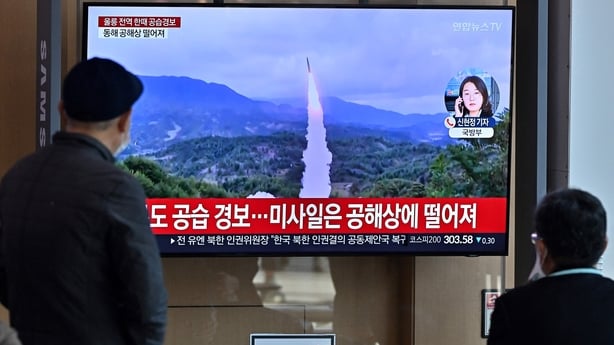North Korea has fired two ballistic missiles, South Korea's military said, days after North Korea announced a successful test of a solid-fuel motor for a new weapons system.
Military tensions on the Korean peninsula have risen sharply this year as North Korea has carried out an unprecedented blitz of weapons tests, including the launch of its most advanced intercontinental ballistic missile ever last month.
South Korea's Joint Chiefs of Staff (JCS) said it detected two ballistic missiles that had been fired from the Tongchang-ri area in North Pyongan province.
The missiles were fired from 11:13am (02.13am Irish time) to 12:05pm into the East Sea, referring to the body of water also known as the Sea of Japan, it said.
"Our military has strengthened surveillance and vigilance while closely cooperating with the United States and maintaining a full readiness posture," the JCS added in a statement.
The missile flew some 500km and reached a maximum altitude of around 550km, according to Japan's defence ministry.
"It threatens the peace and security of our country, this region, and the international community, and it is absolutely unacceptable," said senior vice defence minister Toshiro Ino.
The Department of Foreign Affairs has condemned the missile launch by North Korea.
In a post on Twitter, it said that the tests "flagrantly violate UNSC resolutions and pose a real threat to global peace and security". The department called on North Korea to engage in "meaningful dialogue" with the US and South Korea.
Ireland condemns in the strongest terms the latest missile launch by DPRK. These destabilising tests flagrantly violate UNSC resolutions and pose a real threat to global peace and security. pic.twitter.com/i3bjWhIXS0
— Irish Foreign Ministry (@dfatirl) December 18, 2022

The launch comes days after North Korea tested a "high-thrust solid-fuel motor", with state media describing it as an important test "for the development of another new-type strategic weapon system".
Despite heavy international sanctions over its weapons programmes, Pyongyang has built up an arsenal of intercontinental ballistic missiles (ICBMs).
All its known ICBMs are liquid-fuelled, however, and North Korean leader Kim Jong Un has placed strategic priority on developing solid-fuel engines for more advanced missiles.
Mr Kim said this year that he wants North Korea to have the world's most powerful nuclear force, and declared his country an "irreversible" nuclear state.
The wishlist he revealed last year included solid-fuel ICBMs that could be launched from land or submarines.
The latest motor test was a step towards that goal, but it is not clear how far North Korea has come in the development of such a missile, analysts said.
Key party meeting
After overseeing the launch of the Hwasong-17 "monster" missile last month, Mr Kim declared he wanted North Korea to have the world's most powerful nuclear force.
The isolated country's policy direction for next year will be laid out at a key party meeting later this month, and the official Korean Central News Agency earlier reported Mr Kim saying that 2023 would be a "historic year".
In past years, Mr Kim had delivered a speech on 1 January each year, but has recently dropped the tradition in favour of making announcements at the year-end plenary meeting.
In his most recent address, which was released last New Year's Day, Mr Kim focused on domestic affairs.
Experts say while Mr Kim refrained from directly addressing the United States last year, he could change his tone this time around.
The US and South Korea have warned for months this could come in North Korea conducting its seventh nuclear test.
North Korea is under multiple UN Security Council sanctions over its nuclear and missile activity since 2006.

